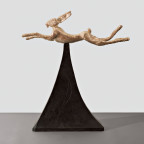Barry Flanagan: Light pieces and other works
Barry Flanagan’s sculpture made with light as a medium are little known. He began directly investigating light in 1968 with a film titled ‘light, shape, short’ and from then on, through the 1970s, he made many works with light as a primary component. He called them ‘light pieces’. This exhibition shows how his dynamic role in the instigation of sculptural approaches to conceptual art practice continues to resonate with contemporary concerns in art practice nearly fifty years later.
Flanagan’s first solo exhibition took place at the Rowan Gallery London in 1966, the month he completed his studies at St Martins School of Art. It occurred simultaneously with Claes Oldenburg’s exhibition at Robert Fraser Gallery. Critics picked up on their shared concerns with soft sculpture and Paul Overy pointed out that Flanagan’s intrigued because although it looked soft, it was in fact, hard. [1] The exhibition included anthropomorphically shaped sculpture made from plaster filled fabric bags, pieces hanging from the ceiling, and a pile of sand poured directly onto the carpeted floor. He ‘wanted to project the show as if in [his] normal working situation. [2]
In 1969 Flanagan had two solo exhibitions, one at the Museum Haus Lange, Krefeld and another in the Fischbach Gallery, New York. For both these exhibitions Flanagan made work in situ, in part as a response to the architecture. Although he was careful to include works whose installation were not designed to be site specific. Flanagan kept logbook records of artwork. Each work is documented by medium, size and exhibition history and most are photographed. On these he detailed the specification for constructing the light pieces. I discussed their re-construction processes and those for the ‘sand sculptures’ with Flanagan. We agreed a set of terms. These light works have been obscured by Flanagan’s bronze hares for reasons in themselves relevant to reflect upon.
Their renewed presence within his practice enables a different way of thinking about how and why the hare became a motif at the time when his investigations turned to figuration, modelling and casting in bronze. His attitude to the medium and exploration of relationships between abstraction and figuration was as unexpected as the soft sculpture and use of building materials had been to its audiences fifteen years previously.
The artist-run space &Model is an ideal situation in which to try out these works in order to engage in a critical discussion with an extended community. &Model’s programming and the architectural qualities of its spaces make it a sympathetic environment in which to show these works, and its proximity to and good relationship with the Henry Moore Institute Galleries will enable an extended debate. This exhibition concentrates on a selection of the light pieces, some realised for the first time, together with a major sand sculpture, one ton corner piece, 1967, documentation, posters and archival material.
1.Overy, Paul. ‘The Listener.’ August 18, 1966.
2.Baro, Gene with Barry Flanagan. ‘Sculpture made visible’ Studio International, October 1969, (pp. 122-25) p. 125







